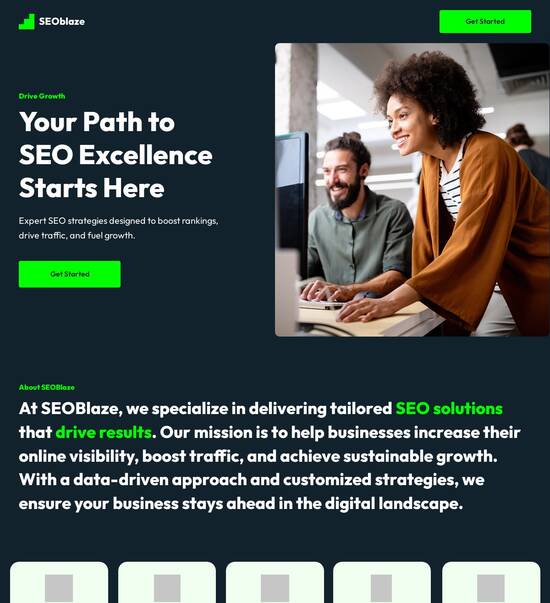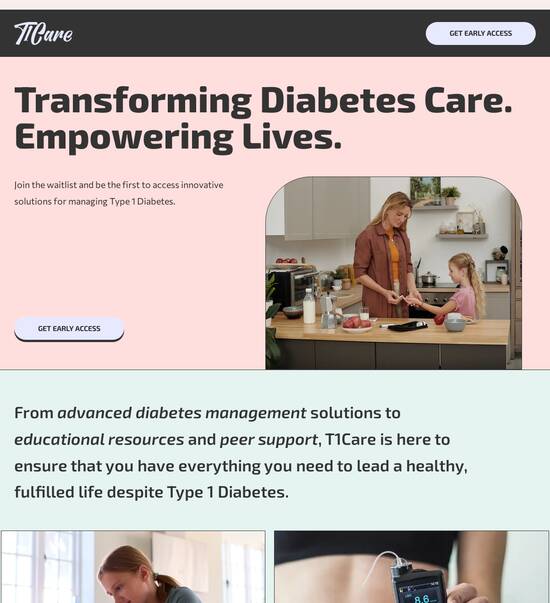
Pitch page template for gaming companies
Explore Similar TemplatesAbout template
Reach out to the right audience with pitch page template for gaming companies
Recommended templates

Easy to build without coding
With the intuitive drag-and-drop builder, anyone on your team can create high-converting pages without any knowledge of code or design. Make enhancements to your landing page with custom widgets using Javascript, HTML/CSS, or third-party scripts.

Multiple layouts for any industry and goal
Select from 500+ landing page layouts built to boost conversions across industry-specific scenarios. Customize them by adjusting fonts, adding images, and generating on-brand content with the AI assistant. Quickly scale with Instablocks® and Global Blocks that you can save, reuse, and update globally.

Loads fast and looks polished on any device
Every template is responsive, which means they present professionally on any device and load blazingly fast with our Thor Render Engine. You can also power them up with Google AMP technology to deliver an unparalleled mobile experience and drive higher conversions.

Robust analytics & experimentation
Get real-time updates and reporting across all your devices, showing the number of visitors, conversions, cost-per-visitor, and cost-per-lead. Launch AI-powered experiments, run A/B tests, and use heatmaps to analyze user behavior, then optimize your landing page to maximize conversions.







Easy to build without coding
With the intuitive drag-and-drop builder, anyone on your team can create high-converting pages without any knowledge of code or design. Make enhancements to your landing page with custom widgets using Javascript, HTML/CSS, or third-party scripts.
Multiple layouts for any industry and goal
Select from 500+ landing page layouts built to boost conversions across industry-specific scenarios. Customize them by adjusting fonts, adding images, and generating on-brand content with the AI assistant. Quickly scale with Instablocks® and Global Blocks that you can save, reuse, and update globally.
Loads fast and looks polished on any device
Every template is responsive, which means they present professionally on any device and load blazingly fast with our Thor Render Engine.
Robust analytics & experimentation
Get real-time updates and reporting across all your devices, showing the number of visitors, conversions, cost-per-visitor, and cost-per-lead. Launch AI-powered experiments, run A/B tests, and use heatmaps to analyze user behavior, then optimize your landing page to maximize conversions.
All the features you need to build lead-generating landing pages
Explore more featuresLearn how to build top-performing landing pages for any goal
FAQs
Leading the way in building high-performing landing pages





An all-in-one landing page solution for marketers
Instapage stands out as the most powerful landing page and CRO platform designed to empower marketers to accelerate and optimize their campaigns. Marketers across various verticals—such as business services, tech, and education—will find tools tailored to maximize their ROI effectively. This guide breaks down the essential steps in leveraging Instapage for superior landing page creation.
Understanding the importance of landing pages
The significance of a well-crafted landing page cannot be understated. Landing pages serve as the focal point of user engagement and conversion. They bridge the gap between marketing campaigns and actual conversions, making them essential for any digital marketing strategy. Elements such as personalization and optimization can drastically enhance performance metrics.
- High conversion rates: A dedicated landing page can increase conversion rates significantly compared to standard website pages by focusing on specific offers.
- Targeted messaging: Landing pages allow marketers to align messaging directly with customer needs, enhancing relevance and engagement.
- Improved campaign tracking: With distinct landing pages for each campaign, tracking performance becomes easier and more insightful.
Step 1: Choosing the right template
Begin by selecting one of the 100+ high-converting templates available in Instapage. These templates cater to various needs, ensuring that your landing page appeals directly to your target audience. Consider the following factors when selecting a template:
- Audience alignment: Ensure the selected template resonates with your specific audience demographics and aligns with your campaign goals.
- A/B testing options: Pick templates that allow for easy A/B testing to compare different layouts, ultimately leading to higher conversions.
- Customizability: Choose a template that can be easily customized to reflect your brand identity while keeping the core focus on conversion.
Step 2: Integrating lead generation elements
After selecting a template, it’s vital to integrate lead generation elements. These components assist in capturing valuable user information. Key elements to include:
- High-quality CTA buttons: Ensure that your Call-to-Action buttons are prominent and compelling to encourage user interaction.
- Contact forms: Use short, concise forms to minimize friction and maximize submissions while collecting essential information.
- Interactive elements: Consider adding lead magnets or interactive incentives that can boost user interest and engagement significantly.
Step 3: Optimize for conversions
Finally, leverage Instapage’s optimization tools to enhance your landing page. Implementing best practices in conversion rate optimization (CRO) can heavily influence your page's success. Focus on:
- Heatmaps and analytics: Utilize heatmaps to analyze user interaction on your landing page. This data provides insights into areas that may require adjustments.
- A/B testing: Budget for running A/B tests on different elements (headlines, images, CTAs) to continually improve your page based on performance data.
- Feedback integration: Actively seek feedback from real users to identify pain points or areas for improvement on your landing page.
By following these steps, you will not just create landing pages but develop powerful conversion tools tailored to your audience's needs.
Ready to maximize the ROI of your digital campaigns? Start with Instapage today and experience the power of optimized landing pages.
People also ask about Pitch page template for gaming companies
Pitch page template for gaming companies
Understanding the essential elements of a pitch page for gaming companies
In the burgeoning world of gaming, a well-crafted pitch page serves as a critical communication tool for developers. The pitch page not only introduces a game concept but also encapsulates the vision behind it, providing potential publishers or investors with enticing details to secure their support. Crafting a compelling pitch is essential, especially in an industry where creativity and innovation are paramount.
The integral role of pitch pages in the gaming industry
A compelling pitch can differentiate successful projects from those that flounder. Game developers need to convey their ideas succinctly and effectively, highlighting their unique features and potential market appeal. The landscape of video game pitch pages is unique because it often involves engaging multimedia and storytelling elements that reflect the interactive nature of games. The approach to pitching can vary significantly based on whether the developer is an indie creator or a member of a larger studio.
Indie developers may prioritize creativity and originality, focusing on innovative gameplay or narrative aspects to grab attention. In contrast, larger studios often leverage established franchises or advanced technology, necessitating a pitch that showcases improved mechanics or expansive world-building. Understanding these nuances is essential when crafting a pitch page that can effectively communicate a project’s value proposition.
Key components of an effective gaming pitch page template
Overview section
The overview section of a pitch page is typically the first impression potential publishers will have. It should provide a concise summary that intrigues the reader while clearly conveying your game's premise and vision. Consider highlighting the genre, main character, and key narrative elements in a couple of sentences. A well-crafted overview doesn’t just describe the game; it excites the reader by presenting a compelling vision of what the game aims to achieve.
Gameplay mechanics
Articulating the core gameplay features and mechanics is vital in the pitch. This section should outline how players will interact with your game, detailing unique selling points such as combat systems, resource management, or puzzle-solving elements that set your project apart. Highlighting innovative gameplay elements in a clear and structured manner helps attach excitement to the foundational layers of the game, making it easier to understand and visualize.
Visual and artistic direction
Visuals significantly contribute to attracting interest in the gaming world. This section should emphasize the artwork, character designs, and environmental visuals that reflect the game's aesthetic. Utilizing high-quality images and concept art can evoke the game's atmosphere, showcasing the intended visual style. The combination of text and visuals here creates a compelling snapshot that communicates the essence of the game effectively.
Target audience analysis
Understanding your target audience is crucial for any game’s success. Define the demographic and psychographic profile of potential players, detailing their age range, interests, and gaming habits. Additionally, illustrate the market demand and trends that support the game’s concept. This data-driven approach not only strengthens the pitch but also provides potential investors with a clearer understanding of the game’s anticipated reach.
Structuring your pitch deck for maximum impact
The organization of information in your pitch deck directly influences its clarity and effectiveness. A logical progression in narrative development keeps the audience engaged and facilitates understanding. A recommended structure may include the following sections: Overview, Gameplay, Visuals, and Market Analysis, each building on the previous one to create a coherent and compelling narrative. This structured approach not only conveys professionalism but also enhances your chances of resonating with publishers.
Visual hierarchy and design principles
A visually appealing layout can make all the difference in your pitch presentation. Focus on creating a design that reflects the game’s theme while also adhering to good design principles, like balanced white space, cohesive color schemes, and readable typography. Use graphics and imagery to break up text-heavy sections, ensuring that the pitch isn’t just informational but also a visually engaging experience that reflects the quality and creativity of the game.
Identifying your publisher and studio needs
Understanding the type of publisher you’re pitching to is essential. Different publishers have unique expectations and areas of focus, so tailoring your pitch accordingly can increase your chances of success. Major publishers often seek high financial returns and mass market appeal, while indie-friendly publishers may prioritize creativity and innovative gameplay. Articulating how your game aligns with the publisher's goals and audience can create a stronger case for their involvement.
When approaching a specific publisher or studio, do thorough research on their past projects and current interests. Highlight aspects of your project that align with their typical portfolio or values. This not only personalizes your pitch but also demonstrates your commitment to understanding their business and needs, which can foster a deeper connection.
Articulating market research and competitive analysis
Pitch pages should include a thorough analysis of industry trends that pertain to your game. Gathering data on contemporary gaming trends can provide context to your project, showing potential publishers that you have your finger on the pulse of the market. Understanding the competitive landscape is equally important; research similar games, their successes, and failures, to identify opportunities for differentiation.
When discussing your game's viability, be sure to cite existing titles that are similar or have succeeded in the market. Player testimonials and community feedback can also serve as supporting evidence that strengthens your proposal. By presenting relevant market data and success stories, you can build a strong case for why your game should capture their interest.
Emphasizing development stage and milestones
Most publishers want to see clear plans regarding a game’s development timeline. Outline your project's key milestones and what steps you have completed thus far, from concept art to gameplay prototypes. Clearly demonstrating your readiness for investment is incredibly important; if potential backers see that you have a well-organized plan and clear objectives, they will have more confidence in your project's potential.
Discussing prototyping and testing phases can also provide insight into your game’s development process. Highlight any feedback you've received from playtests or demo sessions to show that your project is not only conceptual but also grounded in real player experiences. This transparency can help foster trust between you and your potential investors.
Leveraging metrics and analytics
Incorporating metrics into your pitch enhances its credibility. Data-driven decisions can significantly influence pitch presentations; metrics like target audience size, engagement stats from any beta testing, or pre-launch marketing effectiveness can paint a clear picture of your game's market potential. Presenting these analytics demonstrates that you have researched your audience and are prepared to address their needs.
Consider presenting a case for ROI (Return on Investment) and long-term profitability for potential backers. Utilize appealing data visuals to translate statistics into easily digestible findings, which can foster a greater understanding of your project’s potential. Supported by data, your pitch becomes less about personal vision and more about a solid business opportunity.
Highlighting team experience and credentials
The experience and credentials of your team can play a significant role in the strength of your pitch. Highlighting the past successes and relevant industry experience of each team member can instill confidence in potential investors. Include insights about team members' previous projects, awards, and contributions to well-known titles to emphasize their expertise.
Moreover, discussing collaborations and network advantages within the gaming community can help illustrate the strength of your team structure. Highlight how your connections may offer opportunities for mentorship, marketing, or production support. Demonstrating a well-rounded team with a solid track record can significantly increase the chances of garnering support for your game.
Innovative tools and resources for pitch development
Creating a successful pitch page often requires leveraging modern tools. Numerous pitch page templates are specifically designed for gaming companies, allowing developers to create captivating presentations efficiently. Utilizing these templates can streamline the pitching process, ensuring that all essential elements are covered and presented professionally.
Explore software and platforms that enhance pitch presentations, including visual content creation tools and analytics and reporting software. These resources not only improve the aesthetics of your pitch but can provide valuable insights that strengthen your arguments. By investing time into these tools, you can create a polished and professional pitch page that stands out in the competitive gaming landscape.
Engaging with your audience: tactics for pitch delivery
The delivery of your pitch can often be as important as the content itself. Effective engagement strategies will influence how publishers perceive your project. Utilize storytelling in your delivery, crafting a narrative arc that resonates well with your audience. This storytelling aspect is especially crucial in the gaming industry, where narrative and engagement are paramount.
Personalizing the pitch experience can also lead to stronger connections. Tailor your story to align with the interests of the publishers you are presenting to, potentially adapting the imagery, tone, or data to better fit their preferences. A personalized pitch conveys to your audience that you've invested time to understand their priorities, which can foster goodwill and increase your chances of success.
Common pitfalls and how to avoid them
Even the most thoughtful game developers can stumble in the pitch process. It’s important to recognize frequent mistakes made, such as being overly verbose, neglecting visuals, or presenting unstructured information. Best practices include refining and perfecting your pitch pages rigorously, potentially engaging peers for constructive feedback. Prior to the final presentation, gather insights from colleagues to hone your content and delivery.
Another common pitfall is underestimating the need for clear visuals. Effective pitches use a blend of strong graphics, intuitive layout, and engaging content to maintain attention. Balancing text-heavy segments with visuals can prevent potential investors from losing interest and is essential in keeping your proposal impactful.
Future trends in game pitching and development
As the gaming industry continues to evolve, so will the methodologies for pitching games. Future pitch pages will likely incorporate more interactive elements, reflecting the increasingly digital-based landscape of presentations. Predictive technologies may also factor into pitch development, providing data-driven insights that inform creative direction and target audience strategies during the pitching phase.
Additionally, the rise of virtual reality and augmented reality is set to change how developers showcase their games. Imagine pitching your game in a virtually immersive environment, providing potential investors a real feel for the gameplay experience. The integration of such technologies into pitch presentations can redefine the standards of engagement, potentially boosting the success rates of securing funding.
Ready to skyrocket conversions?
Supercharge your ad campaigns with high-performing landing pages
Get started














